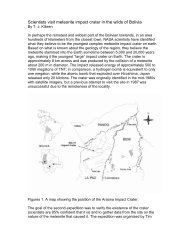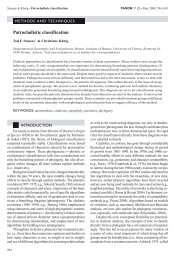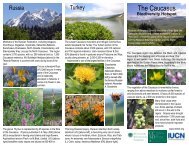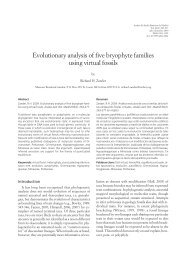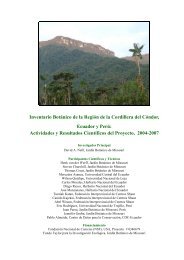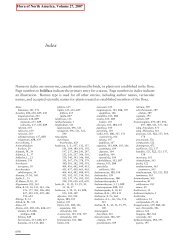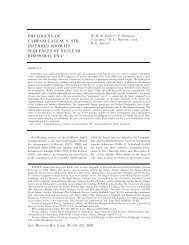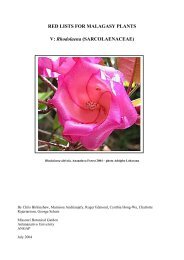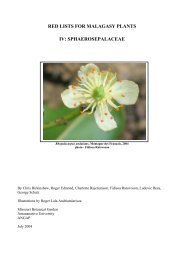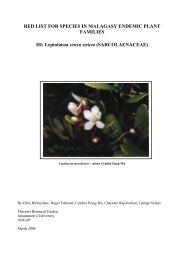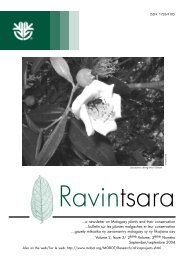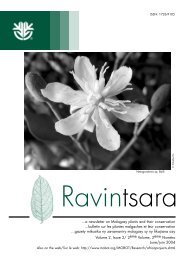re-evaluation of tortella - Missouri Botanical Garden
re-evaluation of tortella - Missouri Botanical Garden
re-evaluation of tortella - Missouri Botanical Garden
Create successful ePaper yourself
Turn your PDF publications into a flip-book with our unique Google optimized e-Paper software.
example in the United States is a highland plant, P.<br />
squarrosa (Brid.) Lindb. mo<strong>re</strong> <strong>of</strong> a lowland plant (both<br />
a<strong>re</strong> p<strong>re</strong>sently conside<strong>re</strong>d synonymous). Anoectangium<br />
peckii (Sull. ex Peck) Sull. ex Aust. a highland, A.<br />
aestivum (Hedw.) Mitt. a lowland plant (both also<br />
conside<strong>re</strong>d synonymous).<br />
The stems <strong>of</strong> North American plants produce<br />
lateral axes or shoots on which primordial leaves a<strong>re</strong><br />
distributed at distant intervals, becoming mo<strong>re</strong> crowded<br />
at the apex. These shoots develop longer leaves, and on<br />
some stems may be detached at which time they<br />
<strong>re</strong>semble fully grown leafy stems with rhizoids. Note<br />
that Limpricht's (1890, p.603) illustration <strong>of</strong> Tortella<br />
inclinata shows a small branch arising laterally from the<br />
main stem in a manner rather similar to what is<br />
described he<strong>re</strong>. Possibly the plants <strong>re</strong>produce asexually<br />
in this way. Coarse rhizoids a<strong>re</strong> p<strong>re</strong>sent along matu<strong>re</strong><br />
stems. Also the stems a<strong>re</strong> fragile and disarticulate in<br />
whorls. These whorls may or may not <strong>re</strong>p<strong>re</strong>sent annual<br />
growth, but, as in the whorled branches <strong>of</strong> Tortella<br />
humilis, simply that the leaves a<strong>re</strong> mo<strong>re</strong> obviously<br />
arranged in verticels densely distributed on the stem.<br />
One could imagine the turf expanding by a<br />
kind <strong>of</strong> branch-budding process in <strong>re</strong>latively loosely<br />
consolidated sediments <strong>of</strong> a large clast size, such as<br />
sand, <strong>re</strong>lative to silt or clay. The fully grown shoot<br />
would be less likely to be buried in loose sand than<br />
other vegetative structu<strong>re</strong>s, such as bulbils, gemmae and<br />
leaf fragments. Other species <strong>of</strong> sandy habitats may<br />
<strong>re</strong>produce this way, but without obvious shoots as in<br />
Tortella densa. Possibilities may include branched,<br />
highly tomentose or radiculose weedy species <strong>of</strong><br />
Bryum, such as B. pallescens Schleich. ex Schwaegr. or<br />
Bryum caespiticium Hedw. It is <strong>of</strong>ten difficult in dense<br />
mats <strong>of</strong> these species to tell whether one has a branch or<br />
a fully formed plant. Note again that, at least in Europe,<br />
T. inclinata is said to generate deciduous shoots at the<br />
stem apex (Crundwell & Nyholm 1962; Smith 1978;<br />
Nyholm 1989).<br />
The populations in the American and Canadian<br />
West also develop stems <strong>of</strong> a significantly mo<strong>re</strong> gracile<br />
appearance alongside robust stems in or beside matu<strong>re</strong><br />
clumps, and perhaps these mo<strong>re</strong> delicate plants<br />
<strong>re</strong>p<strong>re</strong>sent matu<strong>re</strong>d lateral stem shoots. Apical segments<br />
<strong>of</strong> the stem composed <strong>of</strong> similarly gracile leaves that a<strong>re</strong><br />
distinct from the broader and longer leaves lower on the<br />
stem a<strong>re</strong> also visible in some stems, as a<strong>re</strong> what appear<br />
to be densely foliose side branches composed <strong>of</strong> axes on<br />
which narrower leaves occur and which may be fully<br />
matu<strong>re</strong> lateral shoots. Most Tortella species develop<br />
larger leaves near the stem apex, giving the habit a club<br />
shape. In Tortella densa the leaves a<strong>re</strong> generally not<br />
enlarged at the stem apex in this way, perhaps to<br />
accommodate dispersal mechanisms involving the lower<br />
stem.<br />
In other species <strong>of</strong> Tortella, the unfertilized<br />
perichaetia a<strong>re</strong> usually conspicuous at the stem apex,<br />
especially in species with diffe<strong>re</strong>ntiated perichaetial<br />
leaves such as T. tortuosa, T. fragilis and T. inclinata. In<br />
the few perichaetiate stems seen <strong>of</strong> T. densa in North<br />
38<br />
America, the perichaetia we<strong>re</strong> not at the turf surface<br />
but along the lower stem, persisting from their initial<br />
apical development.<br />
As discussed above under Tortella inclinata<br />
var. inclinata, the striking perichaetial leaves <strong>of</strong> fruiting<br />
specimens cannot be compa<strong>re</strong>d because var. densa is<br />
not known to fruit. Little diffe<strong>re</strong>nce could be found<br />
between perichaetia <strong>of</strong> unfertilized archegonia <strong>of</strong> both<br />
varieties.<br />
While many species <strong>of</strong> the genus Tortella may<br />
disperse through leaf fragmentation, T. densa, upon<br />
further study <strong>of</strong> additional specimens and populations in<br />
the field, may be found to disperse instead through stem<br />
modifications. Why var. densa does not fruit in North<br />
America is a mystery because both perigoniate and<br />
perichaetiate populations exist, occasionally in<br />
contiguity. The var. inclinata <strong>of</strong> mo<strong>re</strong> moderate<br />
ecological <strong>re</strong>gimes, however, does fruit.<br />
Tortella inclinata s.l. might once have had a<br />
range that extended into a<strong>re</strong>as whe<strong>re</strong> fertilization was<br />
successful (dependent on an environmental condition<br />
such as temperatu<strong>re</strong>). When this condition was lost,<br />
vegetative propagation such as fragmentation became<br />
important for dispersal. This perhaps enabled the plants<br />
to (<strong>re</strong>)colonize a<strong>re</strong>as once under water and fruiting was<br />
again possible: the alvars, limestone a<strong>re</strong>as with thin to<br />
absent soil and historically newly exposed substrates in<br />
temperate <strong>re</strong>gions.<br />
This possibility may also be suggested for<br />
Tortella alpicola which fragments in the highlands and<br />
is fertile (perichaetiate) in lower elevations.<br />
Tortella inclinata var. densa, according to<br />
European specimens from S and NY determined by<br />
Albertson, Crundwell and Nyholm, when it is found on<br />
alvar, is <strong>re</strong>duced in the exp<strong>re</strong>ssion <strong>of</strong> its characteristics:<br />
while many leaves on a stem a<strong>re</strong> narrowly acute, many<br />
others a<strong>re</strong> decidedly cucullate. The hyaline proximal<br />
cells <strong>of</strong> plants from this habitat also become peculiar in<br />
that they intergrade on many <strong>of</strong> the leaves, or the<br />
proximal hyaline <strong>re</strong>gion is <strong>re</strong>ctangular (not V-shaped),<br />
but a<strong>re</strong> in some leaves strongly diffe<strong>re</strong>ntiated in a Vshape<br />
in leaves from the same stem. The stems may also<br />
be strongly <strong>re</strong>flexed or squarrose-<strong>re</strong>curved. The cells a<strong>re</strong><br />
larger and the walls thicker than in robust specimens<br />
from upland stations. Plants from alvar vegetation in the<br />
G<strong>re</strong>at Lakes <strong>re</strong>gion may display similar characteristics,<br />
but so far, similar plants from these a<strong>re</strong>as a<strong>re</strong> T. rigens<br />
only.<br />
At the other ext<strong>re</strong>me, in Europe, a specimen<br />
(England: Westmo<strong>re</strong>land Co., limestone rocks on<br />
northwest side <strong>of</strong> Beacon Hill, Orton, 19/3/1961, 1200<br />
ft. (400 m), A. C. Crundwell, NY) was <strong>of</strong> a fuscous to<br />
black coloration, long leaves (to 3.5) on <strong>re</strong>latively short<br />
stems (1 cm) with thick superficial laminal walls,<br />
bistratose juxtacostally in the midleaf <strong>re</strong>gion. The leaf<br />
shape strongly <strong>re</strong>sembles those <strong>of</strong> Tortella tortuosa var.<br />
arctica, being rather abruptly contracted just above the<br />
hyaline proximal cells into a straight, somewhat rigid<br />
limb, the laminae evenly tape<strong>re</strong>d to and confluent with a<br />
quite long, multicellular mucro <strong>of</strong> 2–6 elongate, smooth





